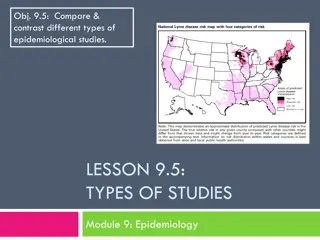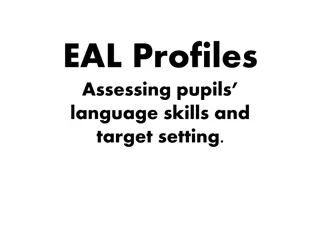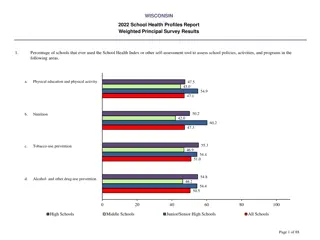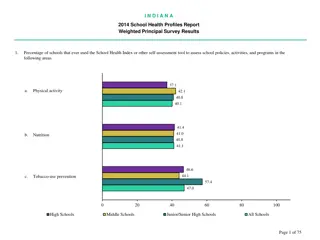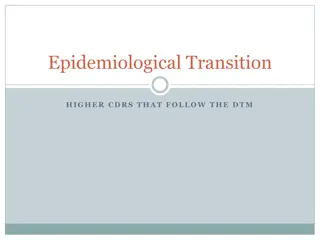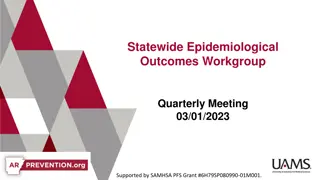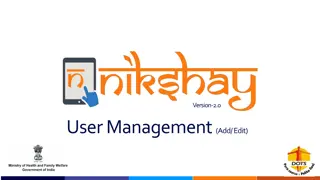Understanding Epidemiological Profiles in Public Health Practice
Epidemiological profiles play a crucial role in substance abuse and mental health planning, helping professionals prioritize issues and raise awareness. The profiles include quantitative and qualitative data to analyze behavioral risk factors, consumption patterns, and clinical outcomes, sourced from various surveys and reports. By understanding this data, practitioners can identify community needs and tailor programs to address them effectively.
Download Presentation

Please find below an Image/Link to download the presentation.
The content on the website is provided AS IS for your information and personal use only. It may not be sold, licensed, or shared on other websites without obtaining consent from the author. Download presentation by click this link. If you encounter any issues during the download, it is possible that the publisher has removed the file from their server.
E N D
Presentation Transcript
Nevadas Epidemiological Profile Julia Peek, MHA Deputy Administrator, Community Services April 29, 2015 Division of Public and Behavioral Health (DPBH) 1
Goals of the Epidemiological Profile Prevention planners and practitioners use epidemiological profiles to understand and prioritize the substance-related problems in their states and communities and increase awareness of these problems. Need to make it a comprehensive substance use and mental health report. Mental health data is often not included 2
Data/Reporting Overlap SAMHSA Epidemiological Profile for Block Grant Certified community behavioral health clinics (CCBHC) needs assessment to identify community needs and determine program capacity to address the needs of the population being served. It can help identify current conditions and desired services or outcomes. A needs assessment should be objective and include input from consumers, program staff, and other key community stakeholders. Coalition Behavioral Health Reports Data to support the MPAC needs 3
Quantitative vs. Qualitative Quantitative data is described in numbers and shows how often something occurs or to what degree a phenomenon exists. Quantitative data measures levels of behavior and trends. It is objective, standardized, and easily analyzed, and is easily comparable to similar data from other communities. Examples of quantitative data include statistics, survey data, records, and archival data. Qualitative data is described in words and explains why people behave or feel the way they do. This type of data answers Why? Why not? or What does it mean? Qualitative data is subjective and explanatory and helps interpret quantitative data by allowing insight into behavior trends and perceptions. Examples of qualitative data include focus groups, key informant interviews, case studies, storytelling, and observations. 4
Types of Data Behavioral risk factors Consumption patterns Clinical data Consequences/ Outcomes 5
Behavioral Health Risks Main sources: Behavioral Risk Factor Surveillance System (BRFSS) Youth Risk Behavior Surveillance System (YRBSS) Several questions related to SU and MH Ability to cross tabulate the questions to get a better understanding of correlations ACEs Google (ex: searches) Influences (many questions from YRBS) 6
Consumption Data BRFSS and YRBSS SAMHSA Behavioral Health Barometer 2015 report National Survey on Drug Use and Health (NSDUH) Education Climate Surveys University Surveys 7
Clinical Data SAPTA Data We need SAPTA certified, but not funded, data as well Hospital Discharge Billing Medicaid Claims EMS Syndromic Surveillance Avatar (MH and SU) PMP Workforce data 8
Outcomes/Consequences Vital records Mortality Law Enforcement/Criminal Justice Traffic Safety Recreational Safety (boating mortality/accidents) Early Intervention Services (perinatal substance use) 9
Presentation of Data Statewide Epi Profile/Needs Assessment To meet SAMHSA and CCBHC requirements Data Dashboards Prescription Drug grant (SNHD) Coalition-level reports 10
Next Steps and Timeline Data pull (through mid-May) Analysis (May to June 1) Report development (June 1 June 15) Report review and edits (June 15 July 1) Presentation to SEW (July) Finalize and release report (end of July) 12
Contact Information Julia Peek Nevada Division of Public and Behavioral Health 775-684-4192 jpeek@health.nv.gov 13










